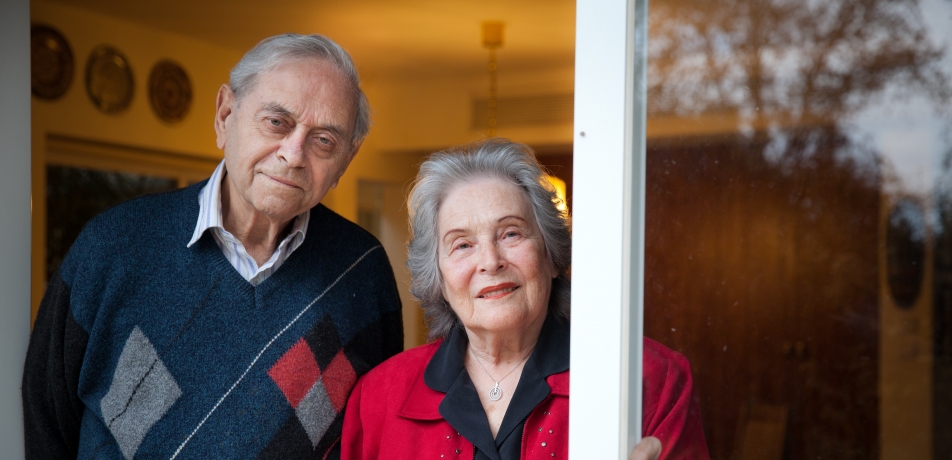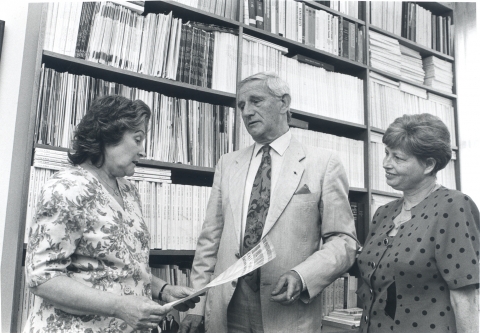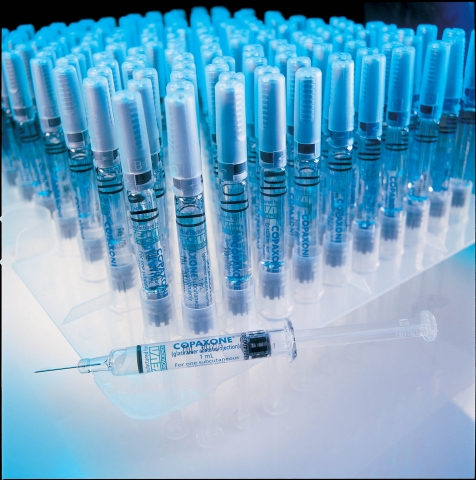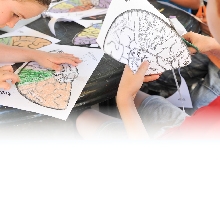Ruth and Uriel Arnon
A legacy of scientific discovery
People behind the science

It was one of the important fields in biology developed during the 20th century—understanding the immune system and how it protects our body from foreign invaders and self-inflicted damage—and in her early years at the Weizmann Institute of Science, Prof. Ruth Arnon stepped right into it.
Fast forward nearly six decades and today she can look back on a stellar career in science that led to the development of the blockbuster drug Copaxone® sold by Teva Pharmaceuticals for multiple sclerosis (MS); national- and international-level leadership roles in the scientific arena in which she has made a major impact on the face of Israeli science; and, most recently, groundbreaking work on the development of a universal influenza vaccine. She and her husband, Uriel, who is an engineer, have lived on campus for decades and raised their children, Michal and Yoram, here.
At the Weizmann Institute, she went on to head the Department of Chemical Immunology and was Dean of Biology in the 1980s. She served as Institute Vice President from 1988-1993. The couple recently gave a transformational gift for the establishment of the Ruth and Uriel Arnon Science Education Campus at the Weizmann Institute, which actualizes the couple’s dream of investing in the future of Israeli science through youth education at the highest level. Uri said the gift was a family decision based on their common conviction of the importance of investing in the future of Israeli science. “Chaim Weizmann said that Israel’s economy will be built on human capital and our ability to develop science and technology,” he says. “And in my view this is right. It is the developments in high tech and science that have brought Israel to its current position in the world. But Israel won’t be able to sustain this position if it doesn’t educate more students in science.”
How did it all happen? From age 15, as a high school student at the prestigious Herzliya Hebrew Gymnasium in Tel Aviv, Ruth had her mind set on working on the scientific basis of medicine. After receiving her MSc in biochemistry at the Hebrew University and completing her army service, Ruth learned that Prof. Ephraim Katchalski (later Katzir, who became the fourth President of Israel), whose research focused on the properties of proteins and the construction of synthetic protein like polymers, was looking for scientists to work on a new project. Ruth had been his student at the Hebrew University, and she recalls, “I mustered the courage to approach him.”
Prof. Katchalski accepted her on the spot as a PhD student but informed her that the project would be with (then-Dr.) Michael Sela, who was about to return from his postdoctoral studies at NIH. Thus, she became Prof. Sela’s first doctoral student; the two worked closely as student and mentor on deciphering the chemical basis of the immunological properties of proteins. These studies culminated in the preparation and characterization of the first synthetic antigen, a material that arouses the immune system. Several years later they were joined by Dr. Dvorah Teitelbaum (first as a student, then as a research associate in the Department of Immunology; she died in 2008). The trio set out to study a model disease for multiple sclerosis (MS) in mice that is induced by injection of a brain protein, in an attempt to better understand its mechanisms. The project began in 1967; the unique approach they took was to synthesize a polymer that would mimic the structure and properties of that brain protein.
Serendipity of the first order
They synthesized a series of polymers, the one that was best characterized denoted Copolymer 1. Their working hypothesis was that it would also induce the disease and provide an excellent research tool. But, after more than a year of work trying to get it to instigate the disease, they realized that perhaps there was something about it that did the opposite. And indeed this was true: Instead of Copolymer 1 working to instigate a model of MS, it did the reverse - it inhibited it.
“We just wanted to know more about how the immune system works,” says Prof. Arnon, adding that MS - an inflammatory autoimmune disease in which the insulating covers of nerve cells in the brain and spinal cord are damaged, leading to debilitating physical and mental symptoms in patients—was a disease that would help elucidate the immune system. “But we discovered that we had stumbled upon something that actually inhibited and suppressed the disease.
These unexpected results led them to switch tracks, to study the therapeutic potential of Copolymer 1. The group spent the next 15 years in experimentation in animals and development, including clinical trials. Teva, then an upstart Israeli drug company trying to prove its worth in the 1980s, purchased the rights to Copolymer 1 in 1987; it became the company’s first innovative drug product. The drug received FDA approval in 1996, almost 30 years after the beginning of the project.
Today, some 40 percent of the world’s MS patients take Copaxone®.
The drug was one of the most important discoveries to have emerged from basic scientific research because it translated into one of the biggest pharmaceutical success stories in Israeli history.
Toward a universal flu vaccine
Today, Prof. Arnon is still involved in studies on the mode of action of Copaxone®, and in parallel she is developing a universal flu vaccine. The vaccine work was a logical outgrowth of her work on synthetic antigens, she says. “The thinking was: If the immune response, namely specific antibodies, can suppress the activity of some biologically active proteins, such as enzymes, can we suppress the activity of a protein that is a part of a virus?”
Each year, the pharmaceutical industry devises a new influenza vaccine that targets the strain of the virus that is expected in that year. However, the viral proteins change from year to year, so there is never a guarantee of the vaccine’s efficacy. Prof. Arnon set out to find a synthetic molecule that comprises pieces of the virus that are conserved among different strains.
The early experiments—over 15 years—on the flu were promising, and in 2003, the biotech company BiondVax was established based on a licensing agreement with the Institute. The company has advanced to phase II clinical trials for its Universal Flu Vaccine, M-001, which is based on a combination of peptides common to nearly all existing (and future) flu virus strains, including both seasonal and pandemic flu strains such as the avian and swine flu. The potential vaccine will work similarly to a tetanus virus, requiring innoculation once in five to 10 years.
Advancing a national agenda
Prof. Arnon has held a variety of national and international- level roles. Since 2010, she has served as President of the Israel Academy of Sciences and Humanities, where she has played a leading role in advancing a national strategy on science; she is the first woman in that role. She won the Israel Prize, the Wolf Prize, and the Rothschild Prize.
As President of the Israel Academy, she manages the Academy’s role as advisor to the government on all matters of national importance related to science. She also oversees the Academy’s role in promoting basic research in the country, fostering interaction between Israeli scientists and international scientific facilities and organizations, and deepening relationships with other countries’ national academies. She is also chairperson of the council of the Israel Science Foundation (ISF), the country’s predominant source of competitive grants for basic research. The most pressing agenda item, in her mind, in her role as President of the Academy, she says, is ensuring Israel retains its leading role in science and technology, “which requires deep thinking about and investment in our next generation.”

Prof. Ruth Arnon
Class act: The Ruth and Uriel Arnon Science
Education Campus
Ruth and Uriel Arnon’s latest gift to the Weizmann Institute, and their largest to date, established the Ruth and Uriel Arnon Science Education Campus, which houses a new center for science education, similar to the one that has proved so successful in Tel Aviv.
One of the Institute’s biggest success stories in the field of youth science education is The Schwartz/ Reisman Science Education Center (also known as HEMDA) in Tel Aviv, established in 1991, the brainchild of former Weizmann Institute President Prof. Haim Harari (Prof. Daniel Zajfman now serves as its Chairman). It began as an experiment in regional science education: Students from almost all Tel Aviv high schools who excel in science receive their physics and chemistry education at that center in lieu of at their schools, and are taught by professional teachers with advanced science degrees .
The Tel Aviv center’s success - evidenced in matriculation grades and other measures - gave impetus to the formation of the second such center in Rehovot, adjacent to the Weizmann Institute campus. The Schwartz/Reisman Science Education Center, which will be located in a new area called the Ruth and Uriel Arnon Science Education Campus, adjacent to the Davidson Institute on land provided by the Rehovot municipality - is now temporarily housed at the Davidson Institute for Science Education while the construction of a new facility is underway. It offers quality physics curricular education to excellent science students from seven feeder high schools in Rehovot and Ness Ziona.
The Campus caters to over 500 high-school students in 23 classes. These students benefit from highly trained teachers with advanced science degrees who form a vibrant intellectual community; state-of-the-art lab equipment that any single school cannot offer; and courses at the highest levels of sophistication.
The new building, will include 18 designed “class-labs” equipped with the most advanced materials and equipment, preparation rooms for teachers and lab assistants, and a Fabrication Laboratory (a so-called “Fab Lab”) where students can create tools and parts for experiments from scratch using 3D printers, laser cutters, circuit board printers, and more. The Arnon Campus is thus poised to become a standout in the Israeli educational environment and thereby play a key role in educating the next generations of leaders in Israeli science and technology.
The gift follows an earlier one from the Arnons that established a fund for equipment for this center. Prof. Michael Sela, who collaborated with Prof. Arnon on the development of Copaxone® and previously served as Weizmann Institute President, says about his colleague, “After dozens of years of collaborative work with Ruth, I want to express my pride and heartfelt congratulations to her and Uri on their meaningful support of science education.” Uri points out that about one-fifth of today’s high school students focus their studies on science and math, as compared to about half in their youth. “I am worried about the influence of religious extremism and the disappearance of secularism, in addition to the receding levels of education in science and math; investing in science literacy is therefore our way forward on this issue,” he says.
“What is particularly special about this gift is that it comes from a member of our own scientist community,” says Prof. Daniel Zajfman. “Ruth and Uri are members of the Weizmann family and have helped define the Weizmann community, and in their generosity, they have given back to their home, which is both very moving and also sends a signal of the importance of philanthropy from within Israeli science.”
While closing the issue of Weizmann Magazine, the Weizmann Institute received another magnanimous gift from the Gerald Schwartz and Heather Reisman Foundation of Canada, which in addition to already funding the activities in Tel Aviv and Rehovot, will add a center in Rishon LeZion and most likely an additional one in another location in Israel. You will have the opportunity to read more about Gerald Schwartz and Heather Reisman and their commitment to advancing science education in Israel in an upcoming issue of this magazine.
Prof. Ruth Arnon is funded by Leona M. and Harry B. Helmsley Charitable Trust.

The inventors of Copaxone: Prof. Ruth Arnon, Prof. Michael Sela, Dr. Dvora Teitelbaum

Copaxone, the blockbuster multiple sclerosis drug co-invented by Prof. Arnon.

Dr. Eran Grinvald







